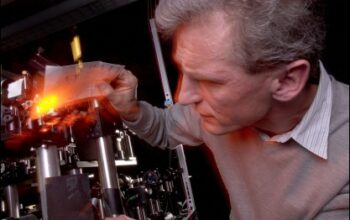Quantum mechanics, with its intricate facets and enigmatic phenomena, has persistently enticed researchers into uncharted realms of knowledge. One of the recent breakthroughs that has captivated the scientific community is the successful capture of fermion interference for the first time. This milestone not only deepens our understanding of quantum behavior but also poses profound questions about the implications of such findings. To what extent can we manipulate these elusive particles to influence a future marked by unprecedented computational advancements?
Fermions, which include particles such as electrons, protons, and neutrons, adhere to the Pauli exclusion principle. This principle holds that no two fermions can occupy the same quantum state concurrently. It is this fundamental characteristic that bestows fermions with unique attributes, setting them apart from bosons, which can coagulate and occupy identical states. The observation of fermion interference challenges conventional paradigms and provides a tantalizing glimpse into the intricate dance of particles at the quantum level.
The significance of capturing fermion interference stems not only from its recognition as a scientific achievement but also from the potential it unveils for quantum computing. Quantum computers harness the principles of quantum mechanics, utilizing superposition and entanglement to address computational problems at magnitudes that classical computers find insurmountable. By understanding fermion behavior and achieving control over their interference patterns, researchers may unlock pathways toward more robust, efficient quantum systems.
The experimental setup utilized in this groundbreaking research involved cooling fermionic atoms to near absolute zero, thereby achieving a state conducive to quantum interference. When subjected to various quantum fields, these atoms exhibited behaviors reminiscent of wave-like properties, leading to distinct interference patterns. Observing these patterns validated theoretical predictions and enabled scientists to explore conditions under which fermions interact. The results challenge long-standing models of particle behavior in quantum mechanics, inviting researchers to reconsider existing theories and methodologies.
As with any compelling scientific discovery, the implications extend far beyond the immediate findings. The prospect of harnessing fermion interference presents a double-edged sword. While the potential applications in quantum computing are promising, the complexity of manipulating fermions raises significant challenges. Can engineers design environments amenable to the stability and control of these particles in larger-scale quantum systems? The transition from theoretical models to practical applications often encounters roadblocks that necessitate innovative solutions and collaborative strategies across multiple disciplines.
Understanding the dynamics of fermion interference does not merely serve the purpose of advancing technology; it propels philosophers and theorists alike to consider the nature of reality itself. What does it mean for particles to exhibit such duality, behaving both as discrete entities and as waves? As the field grapples with these questions, one can anticipate a proliferation of intellectual discourse surrounding the ramifications of fermionic research on our philosophical interpretations of the universe.
Moreover, the effective communication of these complex ideas and findings to wider audiences remains a formidable challenge for the scientific community. The intricacies of quantum mechanics often baffle those unacquainted with the underlying mathematics and physics. Scientists bear the responsibility of elucidating their discoveries in ways that not only advance academic knowledge but also engage public fascination. How do we bridge the gap between esoteric research and widespread comprehension? Achieving this balance is crucial—for the advancement of science relies not only on the pursuit of knowledge but on the collective curiosity it inspires in society.
As this field continues to evolve, one must acknowledge the ethical dimensions inherent in quantum research. The capacity to manipulate subatomic particles could lead to innovations that dramatically alter industries, from computing to cryptography. However, as scientists delve deeper into these possibilities, it is critical to contemplate the ethical ramifications of such power. Is humanity prepared to navigate the complexities that accompany the mastery of quantum technologies?
Focusing on the immediate future, researchers are already contemplating novel methodologies that may emerge as a direct consequence of this discovery. From enhancing the performance of quantum computers to unprecedented communication systems, the ramifications promise to be both profound and multifaceted. However, the path remains riddled with hurdles. As scientists pursue a greater understanding of fermions and their interference patterns, the community must remain vigilant in addressing potential risks while harnessing the benefits of this immense potential.
In conclusion, capturing fermion interference for the first time serves as a landmark achievement that deepens our insight into quantum mechanics. It raises vital inquiries about the manipulation of matter at the quantum level and its implications for future technologies. While the challenge remains formidable, so too does the prospect of reshaping our understanding of the universe. The pursuit of knowledge in quantum mechanics will undoubtedly continue to expand the horizons of both scientific inquiry and human potential.










